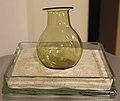KfH Dialysis Museum Fürth
 Exhibition room of the dialysis museum |
|
| Data | |
|---|---|
| place |
Fürth |
| Art | |
| opening | 1990 |
| operator |
KfH dialysis center
|
| Website | |
The KfH Dialysis Museum in Fürth documents the history of blood purification and dialysis from antiquity to the present. It is located in the Jakob-Henle -Haus near the Fürth Clinic , which primarily houses a dialysis center of the Kuratorium for Dialysis and Kidney Transplantation (KfH).
history
The museum in Fürth was founded in 1990 by the then senior sister of the Fürth KfH dialysis center Heidemarie Alexander (1942–2015) and expanded with the support of the senior doctors Josef Nikolay and Beatrix Büschges-Seraphin, their nursing colleagues and the Board of Trustees for Dialysis and Kidney Transplantation.
Duration
In the entrance area, the museum shows a reproduction of a urine sight glass from 1550. At the beginning of the exhibition space, Thomas Graham is introduced, who, after various experiments with membranes, coined the term dialysis in 1854.
As replicas of dialysis machines can be seen:
- the first artificial kidney, which was used for dialysis in animal experiments in 1913 by the scientists JJ Abel, LG Rountree and BB Turner,
- the artificial kidney with which Georg Haas dialyzed a person for the first time in 1924 in Gießen ,
- Willem Kolff's rotating drum kidney , with which a person could be successfully dialyzed for the first time in 1945.
- a vertical drum kidney by Nils Alwall
The original is in the museum among other things
- a Beck blood mill after Ernst Pohl ,
- the Moeller cardioid (type III) from 1955, developed by Curt Moeller since 1948,
- a Travenol tank kidney from 1960,
- an RSP (Single pass recirculating hemodialysis machine) with blood pump (Travenol) and coil dialyzer (Avon) from 1968,
- a Stuttgart kidney developed by Erich Streicher (manufacturer: Fresenius ) (1970),
- a trunk kidney from Union Carbide Cooperation (1975),
- Dialysis machines from the former GDR ,
- Plate dialyzers according to Frederik Kiil .
Apart from that, numerous other dialysis machines and dialysis catheters will be shown and the development of dialysis shunts will be illustrated.
See also
literature
- Eckart Roloff and Karin Henke-Wendt: When it comes to the kidneys: Dialysis saves lives. (The KfH Dialysis Museum in Fürth) In: Visit your doctor or pharmacist. A tour through Germany's museums for medicine and pharmacy. Volume 2, Southern Germany. Verlag S. Hirzel, Stuttgart 2015, pp. 99-101, ISBN 978-3-7776-2511-9 .
Web links
- Dialysis Museum Fürth - on the Internet
- Virtual tour (video)
- Carl Magnus Kjellstrand: History of Dialysis, Men and Ideas . Talk given to the Nordic Nephrology Days Symposium, Lund, 1997.
- Interest group kidney Schweinfurt / Haßberge eV: history of dialysis .
Individual evidence
- ↑ Abel, JJ, Rountree, LG, and Turner, BB The removal of diffusible substances from the circulating blood by means of dialysis . Tn. Assoc. At the. Phys., 28:51, 1913.
- ↑ Georg Haas (1886–1971): The Forgotten Hemodialysis Pioneer (PDF) ( Memento of the original dated December 2, 2007 in the Internet Archive ) Info: The archive link was automatically inserted and not yet checked. Please check the original and archive link according to the instructions and then remove this notice.
- ^ Kolff, WJ, and Berk, HTJ Artificial kidney, dialyzer with great area . Geneesk. gids., 21: 1944.
- ^ University of Lund website: Nils Alwall.
- ↑ Dr. Curt Moeller - Memorial Foundation
- ^ Interest group Niere Schweinfurt / Haßberge eV: 1963: Plate dialyzer by Frederik Kiil, Norway








